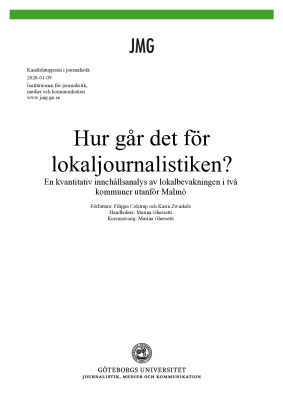Hur går det för lokaljournalistiken?
En kvantitativ innehållsanalys av lokalbevakningen i två kommuner utanför Malmö
In the big city regions in Sweden, with their growing populations, the local newspapers have a large number of municipalities to cover and do not have the same space for every municipality as in local newspapers in other parts of Sweden. Previous studies have shown that many municipalities located within commuting distance from the big cities are covered by local newspapers and public service media as well as hyperlocal media, such as free weeklies and local news sites. Hyperlocal media are more local than local newspapers and public service media, but the question is what hyperlocal media can contribute with in relation to the content in other media covering these municipalities.
Thus the aim of this thesis is to study the local coverage of two municipalities outside of Malmö, Burlöv and Vellinge, and to discuss to which extent hyperlocal media are a complement to local and regional media. The focus lies on the coverage in hyperlocal media compared to local and regional media as well as the differences between the coverage of the two municipalities. In the analysis we have related our results to theories on the role of media in democracy, media ecology and the commercialization of media.
The study is based on a quantitative content analysis of the total news coverage mentioning either of the two municipalities during eight weeks spread out over 2019. For every article we have looked at the subject, the actors that get to express themselves, credit given to other media sources and the distribution of news versus opinion material.
The main findings of this study are that the majority of the articles were in one of the two local newspapers and that 39 per cent of the articles were in one of the four hyperlocal media outlets. The subjects culture/leisure and trade/industry were more common in the hyperlocal media outlets and crime was more common in the local and regional media outlets. Regarding the actors, the civil sphere was more common in the hyperlocal media outlets whereas the political, bureaucratic and legal spheres were more common in local and regional media. These differences in subjects and actors show that the hyperlocal media do to some extent complement the local and regional media. We also found that there were three times as many articles about Vellinge as about Burlöv. The articles about Vellinge were more often about sport and the articles about Burlöv were more often about crime. The actors corresponding to those subjects were also more common in the corresponding municipality.

